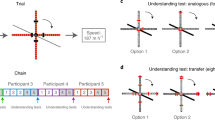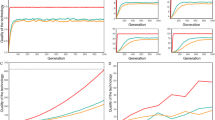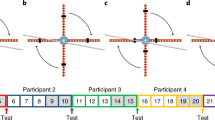Abstract
How do technologies that are too complex for any one individual to produce (“cumulative technological culture”) arise and persist in human populations? Contra prevailing views focusing on social learning, Osiurak and Reynaud (Behav Brain Sci, 2020. https://doi.org/10.1017/s0140525x19003236) argue that the primary driver for cumulative technological culture is our ability for technical reasoning. Whilst sympathetic to their overall position, we argue that two specific aspects of their account are implausible: first, that technical reasoning is unique to humans; and second, that technical reasoning is a necessary condition for the production of cumulative technological culture. We then present our own view, which keeps technical reasoning at the forefront but jettisons these conditions. This produces an account of cumulative technological culture that maintains an important role for technical reasoning, whilst being more evolutionarily plausible.


Similar content being viewed by others
Notes
Here we focus primarily on Osiurak and Reynaud (2020), as it is their most recent and systematic treatment of the issues; but see also De Oliveira et al. (2019), Osiurak and Badets (2016), Osiurak et al. (2016), Reynaud et al. (2016) and Zwirner and Thornton (2015) for important earlier work on the role of technical reasoning in cumulative technological culture.
Osiurak and Reynaud’s view is similar to these accounts insofar as they stress the importance of technical and causal reasoning. Importantly though, on the cognitive niche hypothesis these capacities are thought to be domain general, while on Osiurak and Reynaud’s account they are domain specific.
Thanks to Kim Sterelny for alerting us to this point.
Before moving on, we feel it is important to draw attention to some serious metaphysical and empirical questions sitting in the background here surrounding the individuation of traits and what counts as a novelty or innovation in the evolutionary context. These issues are particularly challenging when we look at something functionally defined like a cognitive mechanism (Brown 2014). Short of solving these challenges (a project in itself), we assume here that a difference of kind of the type Osiurak and Reynaud advocate requires a novel mechanism to arise via some mechanism of innovation. There are many candidate ways this could happen, such as the duplication of cognitive architecture and then divergence (akin to serial homologues in anatomy), or by significant changes to an existing mechanism such that it has a very different functional profile (such as we might see in the evolution of a flipper from a terrestrial limb). For our purposes, what is important is that there is a functional gap between what comes before and what comes after this innovative process.
References
Barrett, H. C., Cosmides, L., & Tooby, J. (2007). The hominid entry into the cognitive niche. In The evolution of mind: Fundamental questions and controversies, pp. 241–248.
Berwick, R. C., & Chomsky, N. (2016). Why only us: Language and evolution. Cambridge: MIT Press.
Bonta, M., Gosford, R., Eussen, D., Ferguson, N., Loveless, E., & Witwer, M. (2017). Intentional fire-spreading by “Firehawk” raptors in Northern Australia. Journal of Ethnobiology, 37(4), 700–718. https://doi.org/10.2993/0278-0771-37.4.700.
Boyd, R. (2017). A different kind of animal: How culture transformed our species. Princeton: Princeton University Press.
Boyd, R., & Richerson, P. J. (1988). Culture and the evolutionary process. Chicago: University of Chicago Press.
Boyd, R., & Richerson, P. J. (1996). Why culture is common, but cultural evolution is rare. Proceedings of the British Academy, 88, 77–93.
Boyd, R., Richerson, P. J., & Henrich, J. (2011). The cultural niche: Why social learning is essential for human adaptation. Proceedings of the National Academy of Sciences, 108(Supplement 2), 10918–10925. https://doi.org/10.1073/pnas.1100290108.
Brown, R. L. (2014). Identifying behavioral novelty. Biological Theory, 9(2), 135–148. https://doi.org/10.1007/s13752-013-0150-y.
Bugnyar, T. (2019). Tool use: New Caledonian crows engage in mental planning. Current Biology, 29(6), R200–R202. https://doi.org/10.1016/j.cub.2019.01.059.
Coolidge, F. L., & Wynn, T. (2018). The rise of homo sapiens: The evolution of modern thinking (2nd ed.). Oxford, New York: Oxford University Press.
de la Torre, I., Mora, R., Domı́nguez-Rodrigo, M., de Luque, L., & Alcalá, L. (2003). The Oldowan industry of Peninj and its bearing on the reconstruction of the technological skills of LowerPleistocene hominids. Journal of Human Evolution, 44(2), 203–224. https://doi.org/10.1016/S0047-2484(02)00206-3.
Dean, L. G., Kendal, R. L., Schapiro, S. J., Thierry, B., & Laland, K. N. (2012). Identification of the social and cognitive processes underlying human cumulative culture. Science, 335(6072), 1114–1118.
Fisher, R. A., & Bennett, H. (Eds.). (1999). The genetical theory of natural selection: A complete (Variorum ed.). Oxford, New York: Oxford University Press.
Gruber, R., Schiestl, M., Boeckle, M., Frohnwieser, A., Miller, R., Gray, R. D., et al. (2019). New Caledonian crows use mental representations to solve metatool problems. Current Biology, 29(4), 686.e3–692.e3. https://doi.org/10.1016/j.cub.2019.01.008.
Horner, V., Whiten, A., Flynn, E., & de Waal, Frans B. M. (2006). Faithful replication of foraging techniques along cultural transmission chains by chimpanzees and children. Proceedings of the National Academy of Sciences of the United States of America, 103(37), 13878–13883. https://doi.org/10.1073/pnas.0606015103.
Hunt, G. R. (1996). Manufacture and use of hook-tools by New Caledonian Crows. Nature, 379(6562), 249–251. https://doi.org/10.1038/379249a0.
Hunt, G. R. (2014). New Caledonian crows’ (Corvus moneduloides) pandanus tool designs: Diversification or independent invention? The Wilson Journal of Ornithology, 126(1), 133–139. https://doi.org/10.1676/13-085.1.
Hunt, G. R., & Gray, R. D. (2003). Diversification and cumulative evolution in New Caledonian crow tool manufacture’. Proceedings of the Royal Society of London. Series B:Biological Sciences, 270(1517), 867–874. https://doi.org/10.1098/rspb.2002.2302.
Jelbert, S. A., Miller, R., Schiestl, M., Boeckle, M., Cheke, L. G., Gray, R. D., et al. (2019). New Caledonian crows infer the weight of objects from observing their movements in a breeze. Proceedings of the Royal Society B: Biological Sciences, 286(1894), 20182332. https://doi.org/10.1098/rspb.2018.2332.
Kaplan, H., Hill, K., Lancaster, J., & Magdalena Hurtado, A. (2000). A theory of human life history evolution: Diet, intelligence, and longevity. Evolutionary Anthropology: Issues, News, and Reviews, 9(4), 156–185. https://doi.org/10.1002/1520-6505(2000)9:4%3c156:AID-EVAN5%3e3.0.CO;2-7.
Knaebe, B., Taylor, A. H., Elliffe, D. M., & Gray, R. D. (2017). New Caledonian crows show behavioural flexibility when manufacturing their tools. Behaviour, 154(1), 65–91. https://doi.org/10.1163/1568539X-00003411.
Kuhn, S. L. (2020). The evolution of paleolithic technologies: A macroscopic perspective. London: Routledge.
Logan, C. J., Jelbert, S. A., Breen, A. J., Gray, R. D., & Taylor, A. H. (2014). Modifications to the Aesop’s Fable paradigm change New Caledonian crow performances. PLoS ONE, 9(7), e103049. https://doi.org/10.1371/journal.pone.0103049.
Mace, R. (2000). Evolutionary ecology of human life history. Animal Behaviour, 59(1), 1–10. https://doi.org/10.1006/anbe.1999.1287.
Marshall-pescini, S., & Whiten, A. (2008). Chimpanzees (Pan troglodytes) and the question of cumulative culture: An experimental approach. Animal Cognition, 11(3), 449–456. https://doi.org/10.1007/s10071-007-0135-y.
Miller, R., Gruber, R., Frohnwieser, A., Schiestl, M., Jelbert, S. A., Gray, R. D., et al. (2020). Decision-making flexibility in New Caledonian crows, young children and adult humans in a multi-dimensional tool-use task. PLoS ONE, 15(3), e0219874. https://doi.org/10.1371/journal.pone.0219874.
Musgrave, S., Morgan, D., Lonsdorf, E., Mundry, R., & Sanz, C. (2016). Tool transfers are a form of teaching among chimpanzees. Scientific Reports, 6(1), 34783. https://doi.org/10.1038/srep34783.
Oliveira, D., Emmanuel, E. R., & Osiurak, F. (2019). Roles of technical reasoning, theory of mind, creativity, and fluid cognition in cumulative technological culture. Human Nature, 30(3), 326–340. https://doi.org/10.1007/s12110-019-09349-1.
Osiurak, F., & Badets, A. (2016). Tool use and affordance: Manipulation-based versus reasoning-based approaches. Psychological Review, 123(5), 534–568. https://doi.org/10.1037/rev0000027.
Osiurak, F., De Oliveira, E., Navarro, J., Lesourd, M., Claidière, N., & Reynaud, E. (2016). Physical intelligence does matter to cumulative technological culture. Journal of Experimental Psychology: General, 145(8), 941–948. https://doi.org/10.1037/xge0000189.
Osiurak, F., & Reynaud, E. (2020). The elephant in the room: What matters cognitively in cumulative technological culture. Behavioral and Brain Sciences. https://doi.org/10.1017/S0140525X19003236.
Pinker, S. (2010). The cognitive niche: Coevolution of intelligence, sociality, and language. Proceedings of the National Academy of Sciences, 107(Supplement 2), 8993–8999. https://doi.org/10.1073/pnas.0914630107.
Povinelli, D. J., & Frey, S. H. (2016). Constraints on the exploitation of the functional properties of objects in expert tool-using chimpanzees (Pan troglodytes). Cortex, 82, 11–23. https://doi.org/10.1016/j.cortex.2016.05.011.
Reynaud, E., Lesourd, M., Navarro, J., & Osiurak, F. (2016). On the neurocognitive origins of human tool use: A critical review of neuroimaging data. Neuroscience and Biobehavioral Reviews, 64, 421–437. https://doi.org/10.1016/j.neubiorev.2016.03.009.
Richerson, P. J., & Boyd, R. (2008). Not by genes alone: How culture transformed human evolution. Chicago: University of Chicago Press.
Sanz, C., Call, J., & Morgan, D. (2009). Design complexity in termite-fishing tools of chimpanzees (Pan troglodytes). Biology Letters, 5(3), 293–296. https://doi.org/10.1098/rsbl.2008.0786.
Sanz, C., Schöning, C., & Morgan, D. B. (2010). Chimpanzees prey on army ants with specialized tool set. American Journal of Primatology, 72(1), 17–24. https://doi.org/10.1002/ajp.20744.
Sterelny, K. (2011). From hominins to humans: How sapiens became behaviourally modern. Philosophical Transactions: Biological Sciences, 366(1566), 809–822.
Sterelny, K. (2012a). The evolved apprentice. Cambridge: MIT Press.
Sterelny, K. (2012b). Language, gesture, skill: The co-evolutionary foundations of language. Philosophical Transactions of the Royal Society B: Biological Sciences, 367(1599), 2141–2151. https://doi.org/10.1098/rstb.2012.0116.
Sterelny, K. (2016). Cooperation, culture, and conflict. The British Journal for the Philosophy of Science, 67(1), 31–58. https://doi.org/10.1093/bjps/axu024.
Stout, D. (2011). Stone toolmaking and the evolution of human culture and cognition. Philosophical Transactions: Biological Sciences, 366(1567), 1050–1059.
Stout, D., & Chaminade, T. (2012). Stone tools, language and the brain in human evolution. Philosophical Transactions: Biological Sciences, 367(1585), 75–87.
Stout, D., Rogers, M. J., Jaeggi, A. V., & Semaw, S. (2019). Archaeology and the origins of human cumulative culture: A case study from the earliest Oldowan at Gona, Ethiopia. Current Anthropology, 60(3), 309–340. https://doi.org/10.1086/703173.
Stout, D., Semaw, S., Rogers, M. J., & Cauche, D. (2010). Technological variation in the earliest Oldowan from Gona, Afar, Ethiopia. Journal of Human Evolution, 58(6), 474–491. https://doi.org/10.1016/j.jhevol.2010.02.005.
Stout, D., Toth, N., Schick, K., & Chaminade, T. (2008). Neural correlates of early stone age toolmaking: Technology, language and cognition in human evolution. Philosophical Transactions: Biological Sciences, 363(1499), 1939–1949.
Taylor, A. H., Elliffe, D. M., Hunt, G. R., Emery, N. J., Clayton, N. S., & Gray, R. D. (2011). New Caledonian crows learn the functional properties of novel tool types. PLoS ONE, 6(12), e26887. https://doi.org/10.1371/journal.pone.0026887.
Taylor, A. H., Hunt, G. R., Holzhaider, J. C., & Gray, R. D. (2007). Spontaneous metatool use by New Caledonian crows. Current Biology, 17(17), 1504–1507. https://doi.org/10.1016/j.cub.2007.07.057.
Taylor, A. H., Hunt, G. R., Medina, F. S., & Gray, R. D. (2009a). Do New Caledonian crows solve physical problems through causal reasoning? Proceedings. Biological Sciences, 276(1655), 247–254. https://doi.org/10.1098/rspb.2008.1107.
Taylor, A. H., Miller, R., & Gray, R. D. (2012). New Caledonian crows reason about hidden causal agents. Proceedings of the National Academy of Sciences, 109(40), 16389–16391. https://doi.org/10.1073/pnas.1208724109.
Taylor, A., Roberts, R., Hunt, G., & Gray, R. (2009b). Causal reasoning in New Caledonian crows. Communicative & Integrative Biology, 2(4), 311–312. https://doi.org/10.4161/cib.2.4.8224.
Tennie, C., Call, J., & Tomasello, M. (2009). Ratcheting up the ratchet: On the evolution of cumulative culture. Philosophical Transactions of the Royal Society B: Biological Sciences, 364(1528), 2405–2415. https://doi.org/10.1098/rstb.2009.0052.
Tomasello, M. (1999). The human adaptation for culture. Annual Review of Anthropology, 28(1), 509–529. https://doi.org/10.1146/annurev.anthro.28.1.509.
Tomasello, M., Kruger, A. C., & Ratner, H. H. (1993). Cultural learning. Behavioral and Brain Sciences, 16(3), 495–511. https://doi.org/10.1017/S0140525X0003123X.
Vale, G. L., Davis, S. J., Lambeth, S. P., Schapiro, S. J., & Whiten, A. (2017). Acquisition of a socially learned tool use sequence in chimpanzees: Implications for cumulative culture. Evolution and Human Behavior, 38(5), 635–644. https://doi.org/10.1016/j.evolhumbehav.2017.04.007.
Whiten, A. (2011). The scope of culture in chimpanzees, humans and ancestral apes. Philosophical Transactions of the Royal Society B: Biological Sciences, 366(1567), 997–1007. https://doi.org/10.1098/rstb.2010.0334.
Whiten, A., & Erdal, D. (2012). The human socio-cognitive niche and its evolutionary origins. Philosophical Transactions of the Royal Society B: Biological Sciences, 367(1599), 2119–2129. https://doi.org/10.1098/rstb.2012.0114.
Whiten, A., Goodall, J., McGrew, W. C., Nishida, T., et al. (1999). Cultures in chimpanzees. Nature, 399(6737), 682–685. https://doi.org/10.1038/21415.
Whiten, A., Horner, V., & de Waal, Frans B. M. (2005). Conformity to cultural norms of tool use in chimpanzees. Nature, 437(7059), 737–740. https://doi.org/10.1038/nature04047.
Whiten, A., Horner, V., & Marshall-Pescini, S. (2003). Cultural panthropology. Evolutionary Anthropology: Issues, News, and Reviews, 12(2), 92–105. https://doi.org/10.1002/evan.10107.
Whiten, A., Spiteri, A., Horner, V., Bonnie, K. E., Lambeth, S. P., Schapiro, S. J., et al. (2007). Transmission of multiple traditions within and between chimpanzee groups. Current Biology, 17(12), 1038–1043. https://doi.org/10.1016/j.cub.2007.05.031.
Whiten, A., & van Schaik, C. P. (2007). The evolution of animal “cultures” and social intelligence. Philosophical Transactions of the Royal Society B: Biological Sciences, 362(1480), 603–620. https://doi.org/10.1098/rstb.2006.1998.
Wynn, T., & Gowlett, J. (2018). The handaxe reconsidered. Evolutionary Anthropology: Issues, News, and Reviews, 27(1), 21–29. https://doi.org/10.1002/evan.21552.
Yamamoto, S., Humle, T., & Tanaka, M. (2013). Basis for cumulative cultural evolution in chimpanzees: Social learning of a more efficient tool-use technique. PLoS ONE, 8(1), e55768. https://doi.org/10.1371/journal.pone.0055768.
Zwirner, E., & Thornton, A. (2015). Cognitive requirements of cumulative culture: Teaching is useful but not essential. Scientific Reports, 5(1), 1–8. https://doi.org/10.1038/srep16781.
Acknowledgements
We would like to thank Kim Sterelny, Colin Klein, François Osiurak and an anonymous referee for helpful comments.
Funding
This research was funded by an ANU Futures Scheme (Brown) and an ANU Research Scholarship (Pain).
Author information
Authors and Affiliations
Corresponding author
Additional information
Publisher's Note
Springer Nature remains neutral with regard to jurisdictional claims in published maps and institutional affiliations.
Rights and permissions
About this article
Cite this article
Pain, R., Brown, R.L. Mind the gap: a more evolutionarily plausible role for technical reasoning in cumulative technological culture. Synthese 199, 2467–2489 (2021). https://doi.org/10.1007/s11229-020-02894-8
Received:
Accepted:
Published:
Issue Date:
DOI: https://doi.org/10.1007/s11229-020-02894-8




